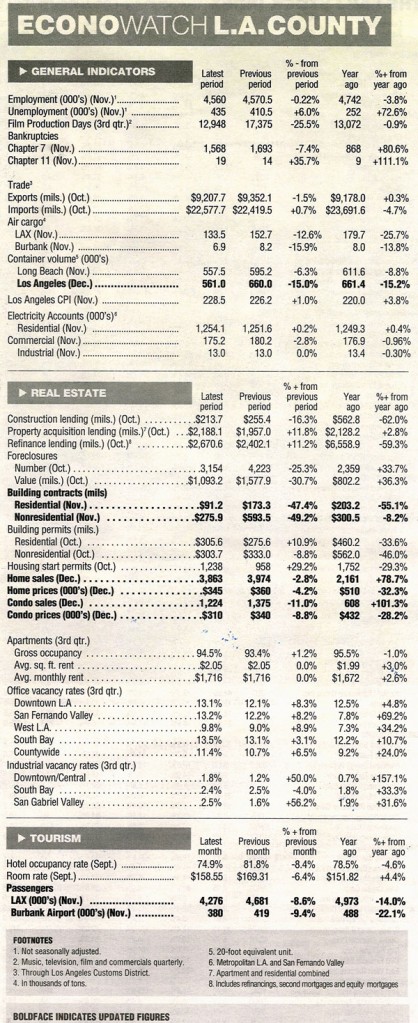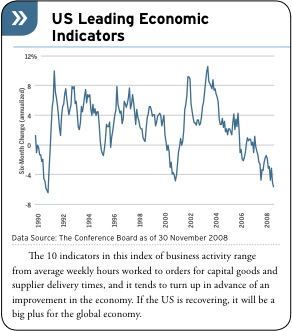Here is a great hot sheet of economic indicators for Los Angeles County. Some statistics are leading while others are lagging indicators.
Category Archives: Market Trends & Indicators
Market trends, leading or lagging indicators. As it relates to industrial property.
Labor Market Update – Continued Gloom Along with Other Indicators

The manufacturing and construction sectors continued to shrink, with job counts plunging by -791,000 jobs and -632,000 jobs respectively compared to December 2007. In manufacturing, about 46% of the total job losses came in just four sectors: motor vehicles & parts (-162,000 jobs and counting), furniture manufacturing (-71,000 jobs), wood products (-76,000 jobs), and textiles & apparel (-56,000 jobs).
Labor market conditions have deteriorated significantly in recent months, and the damage is spreading rapidly. About 55% of the jobs lost during 2008 were in manufacturing and construction. However, that share has been dropping recently, as jobs are disappearing in almost all sectors of private industry (except health services, private education, and mining). The nation’s unemployment rate hit bottom in March, 2007 at 4.4%, when 6.7 million workers were jobless. By last month, the number of workers without a job had grown to 11.1 million, an increase of 4.4 million unemployed. The nation’s labor markets are quite troubled, and more bad news is likely in the next few months.
Although these data are countrywide, the Southern California and Los Angeles economies are not unlike them. These leading indicators are likely an omen of decline for the local warehousing and manufacturing industries and the real estate they occupy.
Market Update – Q4 2008

Losses are projected in real estate values from their 2007 peaks. The lack of real estate financing will prevent us from finding the bottom of the market. However, the Central Los Angeles industrial real estate market is not expected to suffer as much as other industrial markets not only in Southern California but also across the country.
Despite an increase in vacancy rate, the Central Los Angeles industrial real estate submarket continues to maintain the lowest vacancy rates for the nation, despite a decline in demand. Other commercial sectors such as multi-family, office and retail will suffer a far worse fate in the coming 12-24 months. We do expect continued softening in values as demand from buyers and tenants has fallen off substantially. Many companies report revenue drops in the range of 30 to 40 percent for 2008. More properties continue to become available providing a better selection for those who need such space.
The consensus is that the problems which have plagued the second half of 2008 will persist, and possibly worsen into 2009. Consumers have significantly scaled back spending and the reverberations are filtering down all the way to the Los Angeles industrial market as retailers cut their orders for merchandise that once filled warehouse distribution centers to capacity.
The impact of lagging activity will show up in the asking rents and in the increasing levels of available sublease space, especially in industrial markets along the ports’ distribution path. What is unique about thisdownturn is the increase in available warehouse/distribution sublease space. Asking rates will dip as vacancy increases moderately. However the largest concern facing the market in the coming year is how long the national downturn will last and how widespread its effects will be.
As economic specialists scratch their heads in Washington, the rest of the nation and world is forced to wait and see. Because of the overarching economic issues, vacancy will increase a half point and absorption will remain negative in 2009, as rents see a 6-8 percent decrease.
Tougher to Qualify for SBA Loans
The Small Business Administration has tightened the rules on the SBA loan program, which is immensely popular with small industrial companies. New lending caps and restrictions could not arrive at a more sour time due to the recession. LA Times article.
California To Curb Truck Emissions

The California Air Resources Board voted Friday to require trucks after 2011 to gradually reduce emissions of soot and, eventually, nitrous oxides implicated in smog formation. Remedies range from installing diesel exhaust filters at a cost of $10,000 and higher, to buying new engines or replacing trucks altogether.
Nearly all vehicles must be upgraded by 2014, and engines older than 2010 models will have to be replaced between 2012 and 2022. The goal: Reduce soot pollution 85% by 2022. Full article in the Wall Street Journal newspaper.


